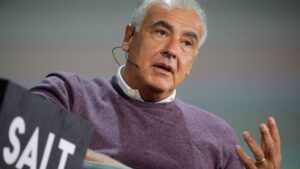The following is a guest editorial courtesy of Carolane de Palmas, Markets Analyst at Retail FX and CFDs broker ActivTrades.
At a time when most advanced economies are still battling stubborn inflation, Switzerland finds itself in the opposite situation: consumer prices are barely rising and, at times, even shrinking. This backdrop has revived speculation that the Swiss National Bank (SNB) could be forced to revisit one of its most controversial policy tools—negative interest rates.
The debate intensified after June 2025, when the SNB cut its policy rate for the sixth time in the current easing cycle, bringing it all the way down to 0%. That move marked a turning point, raising the question of whether sub-zero rates, abandoned only three years ago, might return as a weapon against persistent disinflation and a surging Swiss franc.
Negative rates flip the traditional logic of finance on its head: instead of lenders earning interest, borrowers are effectively paid to take out loans, while commercial banks are charged for holding excess reserves at the central bank. For Switzerland, the measure has long served a dual purpose—stimulating lending and spending at home, while somewhat limiting the franc’s relentless appreciation, which threatens exporters and drags inflation below the SNB’s 2% stability target.
Why Did Switzerland Introduce Negative Rates Back in 2015?
Switzerland opted for negative interest rates in December 2014 as a way to counter the threat of deflation and a dangerously strong franc. When prices fall steadily across the economy, people and businesses delay spending in anticipation of even lower prices ahead. This can trigger a downward spiral of weak demand, shrinking profits, job losses, and slower growth. By pushing rates below zero, the Swiss National Bank hoped to discourage hoarding cash and instead encourage households and firms to borrow, spend, and invest.
The move was also a response to Switzerland’s repeated bouts of deflation. Consumer prices have dipped into negative territory several times over the past decade: from 2011 to 2013, again between 2014 and 2016, and most recently during the pandemic between March 2020 and March 2021. In fact, inflation was negative for roughly a third of all months since 2009. More recently, Switzerland briefly slipped back into negative inflation in May 2025, the first time in four years, though prices have since edged slightly higher. In August, consumer prices rose by just 0.2% compared with a year earlier, underscoring how fragile inflation remains. If key rates remain at 0%, the SNB is forecasting the inflation to reach 0.2% in 2025, 0.5% in 2026 and 0.7% in 2027.
Why Would Switzerland Consider Lowering its Key Rates Below Zero Again?
The debate over whether Switzerland could return to negative interest rates has resurfaced in 2025, largely because of the extraordinary strength of the Swiss franc. The currency has surged to its highest level against the U.S. dollar since 2011, gaining nearly 12% since the start of the year. Against the euro, the franc has appreciated more than 15% since March 2021 and over 21% since March 2018. This relentless rise has kept inflation pinned near its weakest levels in years, raising questions about the Swiss National Bank’s ability to meet its price stability mandate.
Weekly USD/CHF Chart – Source: ActivTrader
A strong franc makes imported goods cheaper, cushioning households and businesses against rising domestic costs. While this may sound like good news for consumers, it risks undermining the SNB’s goal of keeping inflation close to 2%, the level seen as consistent with healthy, sustainable growth. In recent months, inflation has hovered just above zero, with consumer prices rising only 0.2% year-on-year in August. Such subdued price pressures intensify speculation that the SNB may be forced to act again, potentially reviving negative rates as a tool to counter currency-driven disinflation.
SNB Chairman Martin Schlegel has warned that while the central bank is ready to combat low inflation with tools like currency interventions or a return to negative rates, he is also aware of the drawbacks. He notes that the last era of sub-zero rates caused considerable pain for savers, banks, and pension funds.
For now, markets expect the SNB to keep rates unchanged at its next policy meeting on September 25, particularly since inflation has remained within its target range for three consecutive months. Analysts argue that policymakers are likely to stay cautious in the face of heightened global uncertainty—including Washington’s decision to impose 39% tariffs on Swiss imports. Still, officials have been careful to stress that all options remain on the table, reflecting the risks of continued currency appreciation and the fragile inflation outlook.
History adds weight to the current debate. Switzerland became the first major economy to introduce deeply negative interest rates in 2015. The policy lasted nearly eight years, ending only in 2022. A return to negative territory would therefore be both a familiar tool and a controversial one, highlighting just how severe the currency and inflation pressures have become in 2025.
Bond markets suggest that investors are already bracing for the possibility of a policy shift. Yields on short-term Swiss government bonds have slipped back below zero, with two-year yields at around –0.11% in early September, after touching a three-year low of –0.25% in June. Such moves indicate that financial markets see negative rates as more than just a theoretical option—they may become reality again if inflationary pressures weaken further and the franc refuses to soften.
How Can Negative Rates Affect the Swiss Economy?
By charging banks for holding excess reserves at the Swiss National Bank, policymakers aim to incentivize lending and investment rather than saving. But while the theoretical transmission channels are clear, the practical consequences have been more complex—and in some cases problematic—for the Swiss economy.
From a theoretical perspective, negative rates work through several channels. First, they reduce the cost of borrowing, encouraging households and firms to spend and invest. Second, they weaken the domestic currency by making Swiss assets less attractive to foreign investors, which helps exporters. Finally, they push investors up the risk curve, away from safe assets such as government bonds and into equities or real estate, stimulating activity in those sectors.
However, in practice, Switzerland has experienced significant side effects:
- Savers and pension funds: Households earn little to no return on bank deposits, and in some cases face outright charges for holding large balances. Pension funds—heavily reliant on government bonds and low-risk securities—struggle to meet long-term obligations as yields are pushed deeper into negative territory. This undermines retirement security and raises questions about intergenerational fairness.
- Banks and financial stability: Commercial banks can see their net interest margins squeezed, as the gap between what they earn on loans and what they pay on deposits shrinks. To preserve profitability, many have turned to the mortgage market, contributing to a surge in lending and pushing Swiss real estate prices to record highs. The SNB itself has repeatedly warned about overheating risks in housing and the potential buildup of financial imbalances.
- Corporates and investment behavior: While borrowing costs are historically low, companies facing global uncertainty—exacerbated by trade tensions and, more recently, geopolitical shocks—often prefer to sit on cash rather than expand investment. This highlights a theoretical paradox of negative rates: cheaper credit doesn’t necessarily guarantee higher investment if confidence is lacking.
Sources: ING Think, Investopedia, SNB, Reuters, Wall Street Journal









